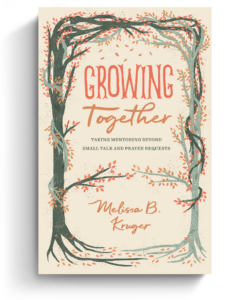As parents, we are our children’s first theology teachers. Like the women at the tomb on Easter morning, we run fearfully and joyfully to tell the people we love, “The tomb is empty! Christ has risen.” With hope-filled hearts, we teach our children about the living Lord.
God has ordained a means for teaching our children how to love him—and not primarily by sending them to AWANA, or buying another picture Bible, or using the right curriculum. Learning about God begins with wonder, and worship is our great goal. Teaching our children theology is as simple as having conversations with God and conversations about God “when you sit in your house, and when you walk by the way, and when you lie down, and when you rise” (Deut. 6:7).
We have conversations with God by reading his Word, giving thanks and praise, and praying to him. In our family, we have conversations about God as we go about our daily routine—sharing meals, walking outside, and perhaps most delightfully, reading books.
Book Adventures
Every new book is a new place, a new journey into new worlds. My husband is our courageous captain. He navigates our ship through the shining seas of Bunyan, Lewis, and Tolkien. These days, we are on an excursion in a dragon’s lair.
Theology, like food, tastes better when one is hungry. Young sailors are often hungry for definitions and explanations, while being full of questions and interruptions. When our captain recently explained various heretical views of the Trinity, our living room roared with laughter. I didn’t know that was possible.
Before the current days of chapter books, however, there were years of shorter adventures in picture books. These too held truths and metaphors helpful for understanding the things of God.
Illustrate and Illuminate
The following picture books aren’t theology books. They should be enjoyed for their clever plots and likeable characters. But they can also illustrate biblical concepts. Through conversations, these picture books may illuminate truths about God in unexpected ways.
The Runaway Bunny by Margaret Wise Brown
Mother bunny gives us a great picture of God’s steadfast love and faithfulness. The Lord never leaves us or forsakes us. He is faithful to pursue us when we run away. He is the fisherman who fishes for us and the “tree we come home to.” His sovereignty is like the wind that blows us where he wants us to go. The little bunny is a lot like Jonah, the runaway prophet. But unlike Jonah, we see the bunny repent.
What Do You Love? by Jonathan London
The question “What do you love?” echoes Jonathan Edwards’s Religious Affections. Parents can help our children to see that the child in the story loves his mommy not for “park slides and piggyback rides.” Rather, he enjoys these good things because he is with his mommy. The nature of true religion is to find our greatest happiness in Christ, not merely his gifts.
Sam and Dave Dig a Hole by Sam Barnett
This book hilariously illustrates double-mindedness. As Sam and Dave dig down, down into the ground they miss enormous chunks of diamonds because they keep changing their minds about which direction to dig. Let us pursue the Lord single-mindedly!
The Little Mouse, the Red Ripe Strawberry, and the Big Hungry Bear by Don and Audrey Wood
“Do not lay up for yourselves treasures on earth, where moth and rust destroy,” or where a big hungry bear might break in and steal. Our hearts are bound up with our red ripe strawberries. I asked my children: What are your red ripe strawberries? How may we store up treasures in heaven instead?
Waiting Is Not Easy by Mo Willems
This book helps us think about why we need patience and serves as a lesson in eschatology for toddlers. How do we answer the question, “Mommy, when is Jesus coming again?” This humorous book gives us five surprisingly profound answers: One, a surprise is a surprise. Two, waiting is not easy. Three, it will get darker before the surprise arrives. Four, sometimes waiting feels like a waste of time. Five, it will all be worth it.
Wonder at the Light
Like John the Baptist, parents who have seen the light are called to be witnesses to the light. Reading with our children will not save them. But we can be the voices crying out in the wilderness, “Prepare the way of the LORD” (Isa. 40:3). We can look for clues to Christ and say, “Behold, the Lamb of God, who takes away the sin of the world!” (John 1:29).
Learning theology begins with a sense of wonder at our risen Lord. May the families of the world fall down and worship.
Involved in Women’s Ministry? Add This to Your Discipleship Toolkit
 We need one another. Yet we don’t always know how to develop deep relationships to help us grow in the Christian life. Younger believers benefit from the guidance and wisdom of more mature saints as their faith deepens. But too often, potential mentors lack clarity and training on how to engage in discipling those they can influence.
We need one another. Yet we don’t always know how to develop deep relationships to help us grow in the Christian life. Younger believers benefit from the guidance and wisdom of more mature saints as their faith deepens. But too often, potential mentors lack clarity and training on how to engage in discipling those they can influence.
Whether you’re longing to find a spiritual mentor or hoping to serve as a guide for someone else, we have a FREE resource to encourage and equip you. In Growing Together: Taking Mentoring Beyond Small Talk and Prayer Requests, Melissa Kruger, TGC’s vice president of discipleship programming, offers encouraging lessons to guide conversations that promote spiritual growth in both the mentee and mentor.

































